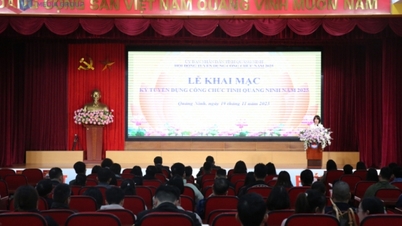Immediately after the Ministry of Education and Training announced the score distribution of the exam subjects, many opinions said that the score distribution was "nice", evenly distributed, the average score was not too low, the number of 10s was not too many, meaning the exam was successful.
In fact, if we look more closely at each subject, especially Math, a compulsory subject, the picture is not "beautiful" and does not ensure the fairness that a national exam needs. This year's Math exam has nearly 60% of candidates below average. The score distribution is clearly skewed, with the peak falling around 3.8-4.2 points, showing that the exam is very difficult for average students and does not differentiate well between good groups.
Natural sciences (Physics, Chemistry, Biology) have high average scores, with a wide range of scores in the 6-8 point range, causing public opinion to question the consistency in exam design. The imbalance between exam subjects is undermining the standardization of the exam. If we continue to use previous years' score ranges as the basis for determining exam policies and admission conversion, especially for each combination, the risk of new paradoxes arising is inevitable.
Although this year's exam was designed according to the 2018 General Education Program, emphasizing capacity development and reducing memorization, reality has shown many shortcomings. The Math subject has many lengthy questions, overloading average students, while the advanced section lacks truly classifying questions, leading to a "broken" score distribution - good students easily achieve unusually high scores, while the majority are below average. This shows that the program is new but the thinking behind the exam questions has not really changed. More worryingly, this year's score distribution is no longer compatible with previous years, but many schools are still forced to use old data to convert admission scores.
The above shortcomings will lead to consequences and possible disruptions when conducting university admissions. Without timely adjustments, the 2025 university admissions season will face many disruptions. First of all, schools do not have standard data to build a scale of scores, which can easily lead to a situation where each place converts differently, and the admission combination is warped.
The discrepancy between the difficulty levels of subjects can cause candidates with high scores in “easy” subjects to surpass those who are truly capable but encounter “tricky” questions, especially unfairly in highly competitive fields. The virtual filtering system, if not updated according to the new score distribution, can lead to discrepancies in quota allocation and admission confirmation - something that happened in 2022. In the long term, if the distorted score distribution continues without corrective measures, trust in the fairness of the exam and the admission mechanism will be seriously eroded.
To avoid these consequences, the Ministry of Education and Training should soon publish full data on score distribution by subject, combination, and region in the form of open data, as a basis for schools to convert scores transparently and scientifically. At the same time, stop using past data for conversion without careful analysis and correction.
In the long term, a national competency scale should be built according to the new curriculum standards, from which to design appropriate exam questions and scoring scales - computer-based testing applications, instead of continuing to pursue a "beautiful score spectrum" but meaningless. The university admission system should also gradually shift to a mechanism of trust - autonomy - diverse and multi-dimensional assessment, instead of relying entirely on an exam with too many unknowns. This year, when the general education program is comprehensively reformed, the assessment of student capacity also needs to be viewed through a new lens - fairer, more accurate, and more humane. Do not let truly capable candidates "fail unfairly" just because the assessment system is patchy, heavily seasonal, and lacks data standards...
Source: https://www.sggp.org.vn/pho-diem-bat-thuong-va-he-luy-cho-xet-tuyen-dai-hoc-post804788.html



![[Photo] National Assembly Chairman Tran Thanh Man attends the VinFuture 2025 Award Ceremony](/_next/image?url=https%3A%2F%2Fvphoto.vietnam.vn%2Fthumb%2F1200x675%2Fvietnam%2Fresource%2FIMAGE%2F2025%2F12%2F05%2F1764951162416_2628509768338816493-6995-jpg.webp&w=3840&q=75)

![[Photo] 60th Anniversary of the Founding of the Vietnam Association of Photographic Artists](/_next/image?url=https%3A%2F%2Fvphoto.vietnam.vn%2Fthumb%2F1200x675%2Fvietnam%2Fresource%2FIMAGE%2F2025%2F12%2F05%2F1764935864512_a1-bnd-0841-9740-jpg.webp&w=3840&q=75)













































































































Comment (0)